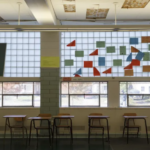by Clifford Michel, THE CITY

This article was originally published, by THE CITY
Staten Island student veterans and military service members who want to attend college in their home borough could catch a break if local Rep. Max Rose’s (D-Staten Island/Brooklyn) bid to end their second-class status succeeds.
Military-affiliated students receive financial support from the federal government for housing, as well as tuition and other costs. But those in Richmond County long have had to settle for far less in housing aid each month than those in the city’s other four boroughs.
That’s because the U.S. Department of Defense lumps in Staten Island with Bayonne, N.J., for purposes of calculating rent and mortgage aid. Last year, that distinction resulted in student veterans studying on Staten Island receiving $453 less per month than their counterparts a ferry ride away.
“I knew a lot of veterans who just couldn’t afford the day-to-day things. They couldn’t put food on the table or get gas,” said Keegan Fernandes, an Army veteran and medical student who holds three degrees from CUNY’s College of Staten Island.
“I had my family, so they would help me with everything,” he added. “But if I didn’t, I think I would’ve gone to another borough or another state that would’ve given me that extra money.”

Rose told THE CITY that Staten Island being grouped with Bayonne makes no sense for the 555 service members who live in the borough and receive what’s called a Basic Allowance for Housing (BAH).
“What has happened as a consequence of this is that the basic housing allowance on Staten Island has at times been so significantly different from the rest of New York City that it has exceeded $1,000 per month,” Rose, a U.S. Army veteran and House Committee on Veterans’ Affairs member, told THE CITY on Friday.
The school-year stipend is currently $3,234 a month in Manhattan, Brooklyn, The Bronx and Queens, compared to $2,781 for Staten Island. In 2018, the median rent on Staten Island was $1,282, which is higher than The Bronx’s median rent and only $92 less than Brooklyn’s, according to U.S. Census Data.
“Even veterans whose families are on Staten Island have not moved back to Staten Island because they wanted to go to a school with a better housing allowance or veterans living on Staten Island have made commutes of over an hour each way so they can go to a school in other borough” — either of which grants them more aid, Rose noted.
Last week, the U.S. House of Representatives passed this year’s National Defense Authorization Act with a provision, pushed by Rose, that will force the DOD to allow only one housing area for cities with a population over 500,000.
The U.S. Senate passed its version of the bill without the provision on Friday. A conference committee will now negotiate a final version.
Students Go Elsewhere
The funding disparity has hit hard at the College of Staten Island.
William Fritz, the college’s president, said the lower housing allowance does a disservice to Staten Island’s student veteran population by encouraging them to forgo an education in their home borough, even though the campus has received honors for being “military friendly.”
“Due to the large discrepancy in BAH, the College of Staten Island has experienced a steady decrease in veteran student enrollment as they transfer to other schools in New York City,” said Fritz, who urged other elected officials to support the measure.
“Veteran student enrollment at CSI will continue to decrease if the BAH is not adjusted to reflect that of New York City and other CUNY institutions,” he added.
In all, eight cities in the U.S. are split but the difference between Staten Island and the rest of New York City is the most glaring — a 14% gulf, though in past years it has been even larger. In 2018, the gap was 28%.
Laura Scazzafavo, director of CSI’s Office of Veteran Services, says student veterans who live on Staten Island tend to seek an education elsewhere, despite the longer commute time. In 2013, she said, CSI had nearly 300 student veterans and dependents. Now, that number has shrunk to 180.
‘An Equal Borough’
Scazzafavo said she saw the effect for herself during a visit to Borough of Manhattan Community College, which Staten Islanders can reach via ferry and subway.
“I met over 80 veterans when I went to BMCC, and eight of them were from Staten Island and attended the school because of the BAH,” said Scazzafavo.
Staten Island is ‘not a part of New Jersey.’
The lower housing allowance is especially burdensome for veterans who can’t easily relocate, according to Scazzafavo, who’s a Navy veteran.
“A lot of them have kids or are single parents, and they say if they could go to another CUNY school for the higher BAH they would, but under the circumstances they can’t do the commute,” said Scazzafavo. “So they live on Staten Island and have kids and CSI’s the perfect place, but they’re getting the short end of the stick.”
Rose was more blunt about what the change would mean for his constituents.
“Staten Island will finally be treated like an equal borough,” said the freshman Democrat. “Finally treated like a part of New York City, which it is — and not a part of New Jersey, which it is not.”
THE CITY is an independent, nonprofit news outlet dedicated to hard-hitting reporting that serves the people of New York.











More Stories
Rhode Island initiative focusing on infrastructure grants
State audit finds just $314,000 in ‘questioned spending’ in $21 billion in federal money
$3.2 million to expand manufacturing operations at Shoal River Ranch gigasite